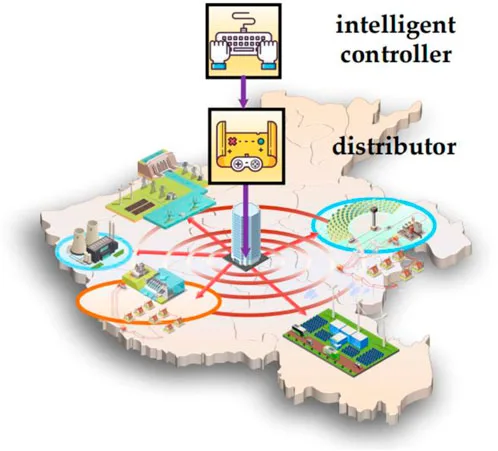Low carbon park islanded microgrids, small-scale power grids that can operate independently or alongside the main grid, face challenges due to the variability of renewable energy sources. This variability can disrupt frequency control performance and increase regulation costs, threatening the microgrid’s stability. Traditional centralized Load Frequency Control (LFC) systems struggle to meet the control demands of large-capacity new energy grid-connected modes. To address this, researchers propose a data-driven intelligent load frequency control (DDILFC) method, using a quantum-inspired maximum entropy actor-critic (QISMEAC) algorithm. This method improves frequency regulation, reduces deviation and generation costs, and enhances the safety and stability of the microgrid.
What is the Challenge with Low Carbon Park Islanded Microgrids?
The low carbon park islanded microgrid, a small-scale power grid that can operate independently or in conjunction with the area’s main electrical grid, faces operational challenges due to the high variability and uncertainty of distributed renewable energy sources. These sources, such as solar and wind power, cause severe random disturbances that impair the frequency control performance and increase the regulation cost of the islanded microgrid, jeopardizing its safety and stability. The frequency control performance is crucial as it reflects the balance between the load power on the demand side and the generator’s power generation in the power system. Maintaining frequency stability is a feasible way to ensure the dynamic stability of the system under strong random disturbances.
The traditional centralized Load Frequency Control (LFC) system, a kind of ultra-short-term frequency regulation technology, has been widely used in power system operation control. However, this system always prioritizes the optimal control performance of its own region, and the information synergy between regions is low. It is hard to meet the control performance demand of a high proportion of large-capacity new energy grid-connected mode with the traditional centralized Automatic Generation Control (AGC) as a vital means of grid scheduling.
What is the Proposed Solution to this Challenge?
To address the problem of frequency control performance in low carbon park islanded microgrids, this paper presents a data-driven intelligent load frequency control (DDILFC) method. The method replaces the conventional LFC controller with an intelligent agent based on a deep reinforcement learning algorithm. This algorithm is designed to adapt to the complex islanded microgrid environment and achieve adaptive multi-objective optimal frequency control.
The paper proposes the quantum-inspired maximum entropy actor-critic (QISMEAC) algorithm, which incorporates the quantum-inspired principle and the maximum entropy exploration strategy into the actor-critic algorithm. The algorithm transforms the experience into a quantum state and leverages the quantum features to improve the deep reinforcement learning’s experience replay mechanism, enhancing the data efficiency and robustness of the algorithm and thus the quality of DDILFC.
How Does the Quantum-Inspired Maximum Entropy Actor-Critic (QISMEAC) Algorithm Work?
The QISMEAC algorithm is a novel approach that combines the principles of quantum physics and the maximum entropy exploration strategy. The algorithm transforms the experience into a quantum state, a concept from quantum physics where a system is in all its possible states at once, until observed. This transformation allows the algorithm to leverage the quantum features to improve the deep reinforcement learning’s experience replay mechanism.
The experience replay mechanism is a method used in reinforcement learning to store and reuse past experiences, similar to how humans learn from past experiences. By enhancing this mechanism, the QISMEAC algorithm improves the data efficiency and robustness of the algorithm, leading to a better quality of DDILFC.
What are the Benefits of the Proposed Method?
The validation on the Yongxing Island isolated microgrid model of China Southern Grid (CSG) demonstrates that the proposed method utilizes the frequency regulation potential of distributed generation and reduces the frequency deviation and generation cost. This means that the method can effectively manage the variability and uncertainty of renewable energy sources, improving the safety and stability of the islanded microgrid.
The proposed method also offers a solution to the limitations of the traditional centralized LFC system. By replacing the conventional LFC controller with an intelligent agent based on a deep reinforcement learning algorithm, the method can adapt to the complex islanded microgrid environment and achieve adaptive multi-objective optimal frequency control. This makes it possible to meet the control performance demand of a high proportion of large-capacity new energy grid-connected mode.
What is the Significance of this Research?
From the perspective of distributed LFC, it is of great significance to seek a class of optimal LFC control strategies for large-scale grid integration of new energy sources based on modern control theory and intelligent optimization methods. These strategies can meet the control performance and operation requirements of power grids under strong stochastic perturbations in the new type of power systems.
This research contributes to this goal by proposing a data-driven intelligent load frequency control (DDILFC) method that utilizes a deep reinforcement learning algorithm. The proposed method offers a solution to the challenges faced by low carbon park islanded microgrids, paving the way for the safe and efficient operation of these grids.
What are the Future Directions of this Research?
While the proposed method has been validated on the Yongxing Island isolated microgrid model of China Southern Grid (CSG), further research is needed to test its applicability to other types of microgrids and under different operating conditions. Future research could also explore ways to further improve the data efficiency and robustness of the QISMEAC algorithm, enhancing the quality of DDILFC.
Moreover, as the renewable energy sector continues to grow, research into optimal LFC control strategies for large-scale grid integration of new energy sources will remain a critical area of study. The findings of this research provide a valuable foundation for future work in this area.
Publication details: “Quantum-inspired deep reinforcement learning for adaptive frequency control of low carbon park island microgrid considering renewable energy sources”
Publication Date: 2024-05-03
Authors: Xin Shen, Jianlin Tang, Feng Pan, Bin Qi, et al.
Source: Frontiers in energy research
DOI: https://doi.org/10.3389/fenrg.2024.1366009

